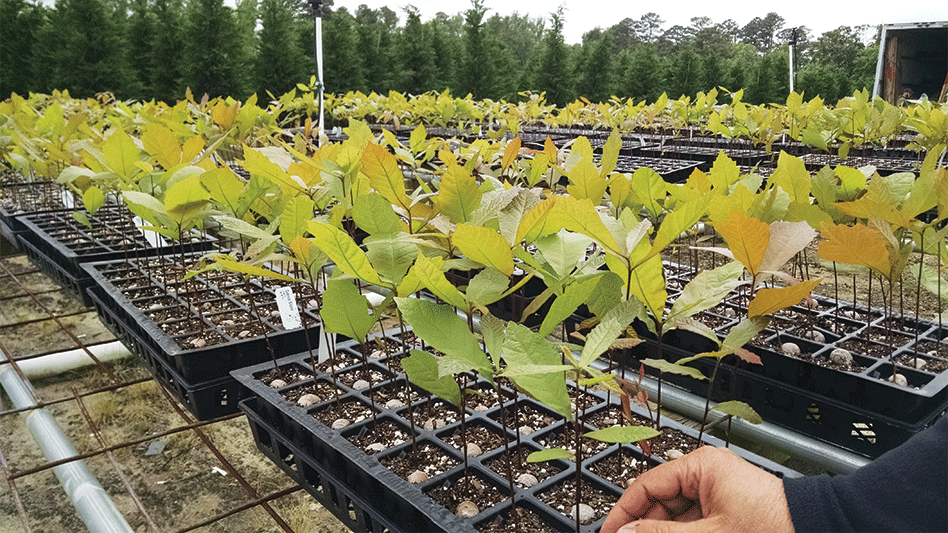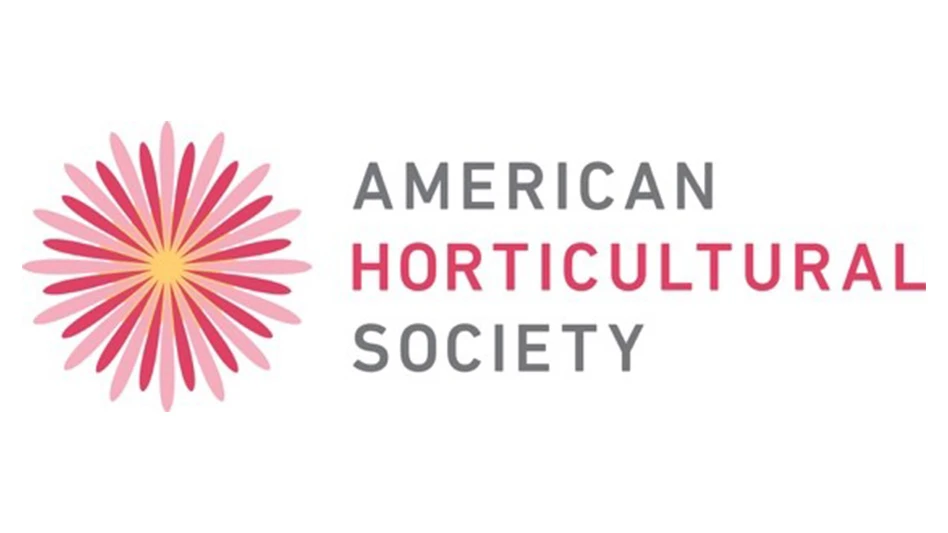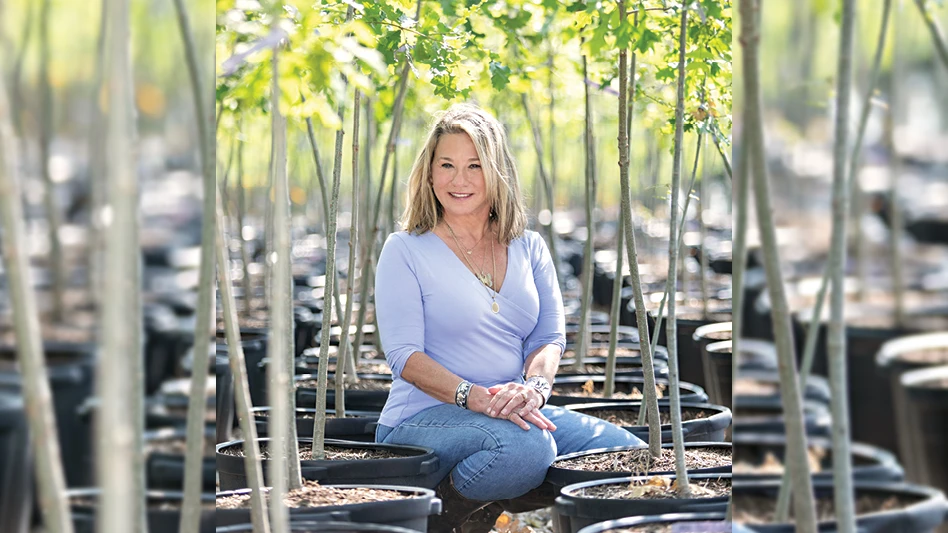
Photo © Martin Bergsma/Adobestock
Containers were filled predominantly with field soils in the early 1900s. The use of peat for horticultural substrates began in the late 1950s. Today, peat has revolutionized container plant production by creating a rootzone environment with less salinity, greater drainage, and fewer root-borne diseases than those filled with mineral soils. It is unofficially considered the gold-standard in growing media by most horticulturists, and the media to which all other components are compared.
With the ever-growing focus on Western Europe and their plans to phase peat out, its use in the United States has become the focus of negative press. The use of horticultural peat has been linked to the degradation of peatlands and a major source of atmospheric carbon contributing to global warming. The New York Times cited environmental leaders exclaiming “the consequences of its continued use on diverse peatland habitats is too high.” The article goes on to explain that “Peat extraction releases substantial carbon dioxide (CO2), a greenhouse gas, contributing to climate change.”
The issue took center stage with an article in National Geographic that claimed horticultural substrates are “dirt-less sterile blends of exotic mosses, fibers, and minerals, ingredients that hide lung disease, water waste, and a whopping carbon footprint.” The declarations in that one passage are both staggeringly inaccurate and completely unsubstantiated.
How much of this bad press is deserved? Extracting peat for horticultural purposes has an environmental cost. But let’s look at the realities of this process and weigh the pros and cons. And instead of using hyperbole and vague declarations, let’s use science and facts.
Peatlands occur in Asia (38.4%), North America (31.6%), Europe (12.5%), South America (11.5%), Africa (4.4%), and Australasia (1.6%). However, the U.S. gets more than 85% of its sphagnum peat from Canadian peatlands, and Canada exports more than 90% of its peat to the U.S., so for the remainder of this article, we will focus on North American sphagnum peat supply and demand. Other parts of the world, especially Europe, have seen most of their peatlands being degraded and disappear due to centuries of using peat for fuel and other products. Correspondingly, Europe has stricter laws and regulations limiting or outright banning the use of horticultural peat. We will focus this article more squarely on the U.S. horticultural peat market predominately supplied by Canadian companies.
North American peatlands
Ombrotrophic peatlands (or bogs, the type of peatland used for horticultural peat harvest) are a type of wetland ecosystem with a broad diversity of plant life but dominated by species of Sphagnum moss. As mosses grow slowly year by year on top of previous years’ growth, older layers below the living surface partially decompose. These partially decomposed peat layers are characterized by low pH due to the buildup of humic acids and are anoxic due to being saturated with water and consequently low levels of oxygen. These characteristics, in addition to the relatively cold soil temperatures throughout Canada, slow the rate of decomposition. This leads to a buildup of partially decomposed sphagnum peat in a near-permanent condition, and thus a long-term storage bank for atmospheric carbon. Preparation of the peatlands for horticultural peat harvest allows the partially decomposed peat to decompose more rapidly and emit CO2 into the atmosphere, becoming a source of CO2 instead of a sink.
There are 294 million acres of peatlands in Canada, according to the United Nations Global Peatland Assessment. That’s almost three times the land area of California. Of that area, approximately 43,500 acres are currently used for peat extraction (with another 34,500 acres having been harvested in the past). That’s about 0.03% of the total peatlands in Canada used for horticultural peat. This small area barely amounts to a rounding error. To keep with the analogy to California, the area of peatlands that has ever been used for horticultural peat could fit within Fresno city limits (compared to an area three times the size of California). More than 97% of peatlands are in an undisturbed and natural state, whereas the remaining 2-3% of disturbed peatlands is due to other forms of agriculture (row crops), mining and human development (housing and commercial real estate).

Greenhouse gases (GHGs) from peat
The crux of almost every argument against horticultural peat is that it results in the emission of greenhouse gases (GHGs). None of the gardening blogs, nor the respected nationally syndicated newspapers or magazines, bothered to offer any details or numbers on this crisis. But I will.
Natural peatlands are prepared for horticultural peat extraction by first draining the top layer of the land through a series of ditches that lower the water table. Then, trees and other vegetation are removed. If necessary, tree roots are extracted (and often used for making additional roads). Finally, the exposed peat is harrowed and readied for vacuum-harvest. One to three inches of vacuum-harvested sphagnum peat is taken off the top of the peatland annually, then stored in a pile along the roadside before being transported to the conditioning and mixing plants where it is sieved, compressed and sealed to maintain moisture and stop decomposition prior to shipping to end users.
Carbon storage and loss from landscapes (or any system) is often described in terms of net ecosystem exchange (NEE). Intact peatlands in an undisturbed or natural state have a negative NEE of about -286 kg of CO2 per hectare (one hectare is equal to 2.4 acres), meaning they accumulate and store more carbon than they emit. For obvious reasons, this is very good in terms of reducing the impacts of global warming.
The process of draining the peat and exposing the subsurface layers to the atmosphere for harvesting allows peat to decompose and release CO2 into the atmosphere. The Intergovernmental Panel on Climate Change (IPCC) estimated (using the crudest models and data available) that an exposed peat bog prepared specifically for horticultural peat extraction releases about 2.8 tons of CO2 per hectare per year. Research by Dr. Hongxing He at McGill University used a coupled heat and mass transfer model for soil-plant-atmospheric systems to predict carbon loss more accurately at 1.5 tons of CO2 per hectare per year. Dr. He validated these models with extensive onsite measurement of CO2 flux, soil moisture, soil temperature and water levels over a period of three years and found the revised estimates far more accurate than the IPCC estimate. To put these numbers into perspective, a single flight on a private jet from Dallas to Chicago releases over 4 tons of CO2 into the atmosphere. That single flight emits two to three times the amount of CO2 than a hectare of exposed peatlands over the course of a year.


Restoring peatlands after harvest
Another argument against the use of horticultural peat is that peatlands can never be restored, at least not in our lifetime. That is a gross oversimplification that glosses over several important details. Let’s look at the numbers.
Once a peatland is opened for extracting horticultural peat, it will usually be harvested for 20 to 40 years, although some deeper bogs could be harvested longer. If harvesting conditions are optimum, up to 3 inches of peat is typically removed each year. A typical peat bog is usually harvested to a remaining depth of 20 inches before it is restored back to a functioning peat bog. The coveted layers of partially decomposed peat only accumulate at a rate of approximately 4-hundredths of an inch (0.04 inches) per year. If a depth of 75 inches was harvested or removed, it would then take about 2,500 years for that peat layer to reform. This is the crux of the argument suggesting that peat bogs can never recover.
There are two practical rebuttals to this assertion. First, considering the infinitesimally small areas being harvested for horticultural peat in the face of the massive land area in Canada covered by peatlands, the total mass of stored carbon in partially decomposing peat layers is accumulating every year despite the harvests. Let’s assume liberally that 4 inches of peat is harvested annually from 43,500 acres currently being extracted, while just 0.04 inches accumulate on the undisturbed 294 million acres. That would equate to approximately 23 million cubic yards of peat harvested, with about 1,500 million cubic yards of new peat accumulated. The peat bogs are growing despite the harvest of horticultural peat. Obviously, this is primarily due to the extremely small area of peat being extracted in the face of massive area of peatlands in Canada.
The second rebuttal is far more important. While it may take millennia for the bogs to reaccumulate the same depth of peat, the bogs return to a carbon sink relatively quickly. After peat is no longer harvested from a given bog, it is restored through a process called the “moss layer transfer technique.” This technique was developed by Dr. Line Rochefort and her team at Laval University in Quebec. It involves taking living fragments of Sphagnum moss from a donor bog and applying them to the surface of the bog being restored or transitioned back to a native-like ecosystem. Dr. Rochefort and her colleagues from the University of Waterloo and McGill University found that 14 years after restoration of a post-extraction peatland, the bog returned to an annual carbon sink with an NEE of -78 grams of carbon per meter per year. There are many factors that can affect the rehabilitation of a post-extraction peatland. Nonetheless, this and other research has shown that peatlands become functioning carbon sinks between 10 to 20 years post restoration, well within our lifetime.

Alternatives to peat
Even if you accept the argument that the land used for harvesting horticultural peat is negligibly small, the amount of carbon released from exposed peat bogs is extremely low relative to other human activities, and that harvested peatlands can be completely and functionally restored to carbon-accumulating sinks, you could argue that any carbon loss is undesirable and alternatives to peat are necessary.
Bark, wood fiber, coconut coir, rock wool, perlite, saw dust and compost are among the most cited products that could serve as alternatives to peat. Many of these products are excellent in very specific applications or can replace a relatively small fraction of the normal peat volume in horticultural substrates. However, none of them (except possibly coir) are suitable to replace peat over the broad range of applications in which it is currently used.
Coir is fibrous, abundant, compressible for shipping, easy to mix with other substrate components and amendments, has a relatively high water holding capacity and has been shown to be an effective substrate across a broad range of crops and applications. Furthermore, fertilizers, plant growth regulators and pest management products that have been developed over the past six decades (largely for use in peat-based substrates) work similarly and effectively in coir-based substrates. There are few modifications that growers need to consider when switching to coir. Other substrates require extensive modification in irrigation, fertilization and pest management. But is coir more sustainable than peat? Does it have less environmental impact or global warming potential than peat?
Every product, action or service has an environmental and societal price tag. Nothing is free. Scientists can quantify impacts on global warming, human health, the environment and society. Instead of offering opinions and soliloquies, let’s take a quantitative look at the carbon footprint and related impacts that peat and other substrates have.
Life cycle assessments (LCAs) are quantitative tools for understanding the impact of any product or service on the environment, human health and society. These analyses consider the carbon, or other inputs, from cradle to grave for the product or service in question. For peat and other substrates, it considers the harvesting, processing, packaging, transportation and all other physical and electrical inputs necessary to manufacture and use a product. These calculations are made with assumptions about where the material originates and how far it is shipped, as well as numerous other assumptions regarding energy rates, fuel rates, etc. Not surprisingly, there is variation in the results from different studies when describing products harvested and transported to different parts of the world.
Figure 1 shows the global warming potential (GWP) of peat, coir and rock wool (or perlite) as calculated by three different groups of scientists, each working with different models and assumptions. Perlite or rock wool were included (depending on the study) to compare a mineral-based substrate as they tend to have extreme impacts compared to organic substrates (like peat and coir) (Toboso-Chavero et al.). As previously discussed, the only fair comparison for this discussion is between peat and coir, as they are the two most interchangeable substrates.
In two of the studies, peat has a slightly higher global warming potential than coir, but in one study (by Paoli et al.), coir has the higher GWP. The authors of this study attribute the higher GWP from coir to the high rates of fertilizer (urea and PO42-) used for producing the coconut crop. Is it fair to attribute the GWP from fertilizer to the coir substrate, since that fertilizer was likely applied to improve fruit yield? Your opinion may vary. Understanding these assumptions is one of the challenges with interpreting life cycle analyses, despite their quantitative nature.
Figure 2 shows the environmental impact from three substrate components across three different studies. Environmental impact includes many factors, such as ozone formation, terrestrial acidification, freshwater and marine eutrophication, land use, water consumption, etc. Because these impacts involve many factors, the data are often normalized and expressed as a percentage of the highest value. For example, the Vinci et al. study calculated that rock wool had the highest environmental impact, while the impact from peat and coir had 2% and 87%, respectively, of the impact caused by rock wool. In every case, the environmental impact from coir is higher than peat, and in two of the three studies, the impact from coir is higher than rock wool. This was attributed to the rewetting process to extract coir pith from the husks, a process that uses a lot of water, as well as the shipping of coir from south Asia.
Figure 3 shows the human health impacts, and once again includes many factors such as toxic effects, carcinogenic effects, respiratory effects, ionizing radiation and ozone depletion. As with the environmental assessment, these data are normalized and expressed as a percent of the most impactful substrate in each study. Once again, peat has a lower impact than coir and rock wool in all three studies.
The blanket statement that peat is more damaging to the environment from greenhouse gases (CO2) and other impacts is not supported by scientific literature. You can scrutinize the methods and assumptions of each study to tease out the conclusions that you want. But an objective examination of all the studies shows that peat is not universally more impactful on health or the environment, and in many cases, it has been shown to be more sustainable than the alternatives that are touted to be its replacement.



Should we harvest peat?
Even if you accept the argument above that peat harvesting is sustainable, you still might question if it is necessary. It most certainly is. Horticultural peat is not being extracted for superfluous reasons like fueling luxury cars or powering private jets. There are three primary reasons that I believe peat is necessary for the horticulture industry and society.
Horticultural peat is used to feed the world. For example, enough peat is harvested each year from a single acre of peatland to grow between 14 and 40 million vegetable seedlings (depending on plug size). Other substrates could be used, but even if you ignored the LCAs above, these other substrates often require more time, more energy, more fertilizer or more water to grow the same crop as peat.
Peat also reforests the world. The volume of peat harvested from a single acre each year can grow more than 3.3 million forest seedlings, which is enough to replant over 6,400 acres of forestland. It is currently estimated that there are over 133 million acres in the continental US that could be reforested, and over 2.2 billion acres worldwide. In order to achieve the U.S. goal, the U.S. forest seedling industry would have to double its output. Currently, only about 25% of forest seedling production is in containers (which predominantly use peat). While seedlings can be grown in-ground, the easiest way to ramp up U.S. capacity would be through container production, as these nurseries have greater potential to expand their infrastructure than in-ground bareroot nurseries.
Finally, peat beautifies the world while providing ecosystems services in our landscapes and improving overall human health. The volume of peat harvested from a single acre each year can grow more than 56 million seedlings of petunias, impatiens, marigold, geranium, etc. Ornamental plantings, especially in urban environments, have been shown to improve our mental wellness, reduce stress and brighten otherwise harsh concrete landscapes. Plants in urban areas also attract wildlife, provide energy savings, reduce heat-island effects, reduce noise pollution, reduce storm-water runoff and improve air quality.

Peat is sustainable and necessary
As horticultural professionals, you might have felt pressure to stop using peat due to the “consequences of its continued use on peatland habitats” or its “whopping carbon footprint.” I believe these claims are exaggerated, misguided and in many ways factually incorrect. If market forces push the horticulture industry to a different substrate in the future, so be it. Environmental ideology that lacks factual basis should never drive our business decisions.
Horticultural peat can be, and is, harvested in a sustainable and responsible manner. Canadian peat harvesters have been doing so for more than three decades. The consequences of harvesting horticultural peat are far less damaging to human health and the environment than the exaggerated claims that gardening blogs would have you believe. And finally, the benefits of using peat for food, forestry and the urban landscape far outweigh the small environmental impact (global warming or otherwise) it has.

Explore the June 2024 Issue
Check out more from this issue and find your next story to read.
Latest from Nursery Management
- The HC Companies, Classic Home & Garden merge as Growscape
- Eason Horticultural Resources will now officially be known as EHR
- BioWorks receives EPA approval for new biological insecticide for thrips, aphids, whiteflies
- Ellen Mackenbach-Lakeman appointed new CEO of Dümmen Orange
- Southern Garden Tour sets 2025 dates for trial garden open houses
- New book explores plants that thrive in Rocky Mountains
- American Floral Endowment establishes Herman Meinders Memorial Tribute
- These companies are utilizing plastic alternatives to reduce horticultural waste





